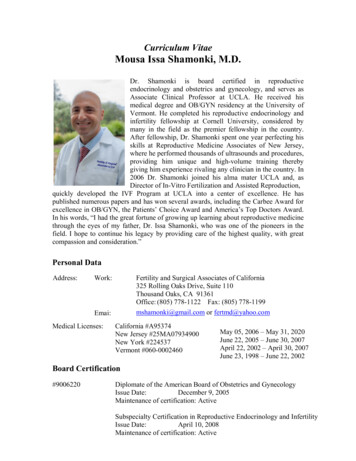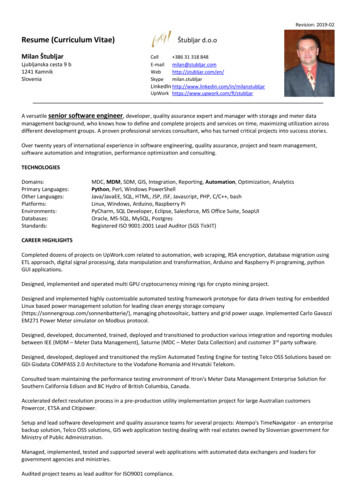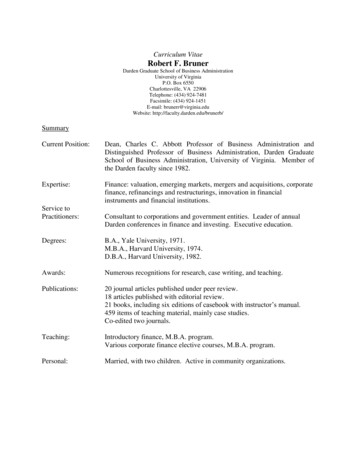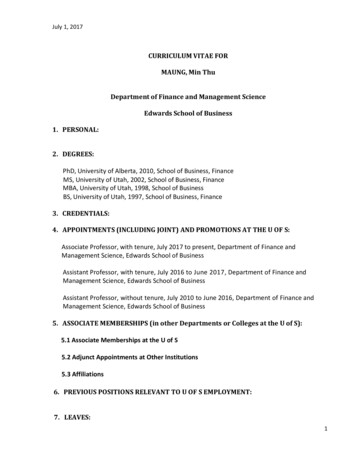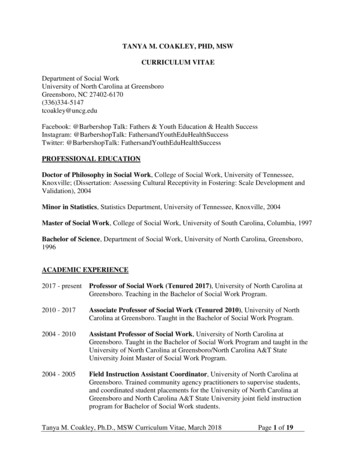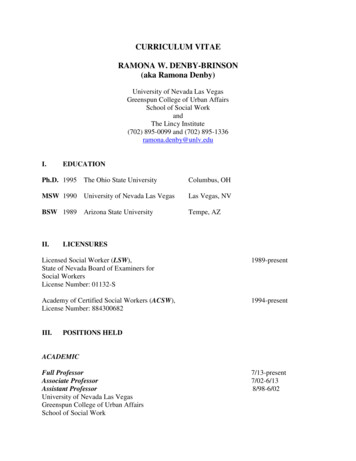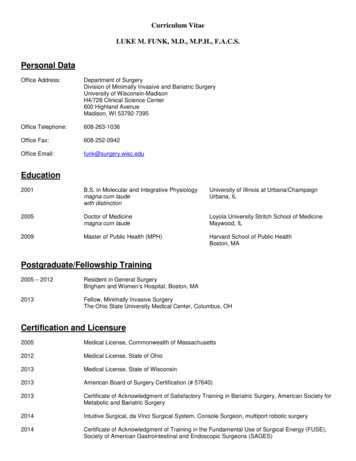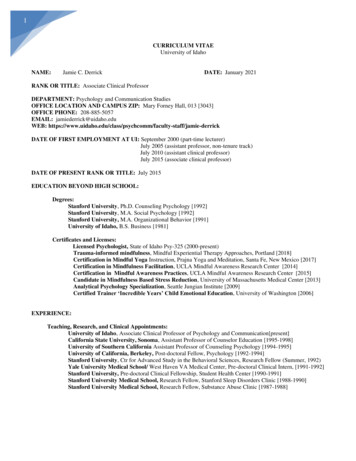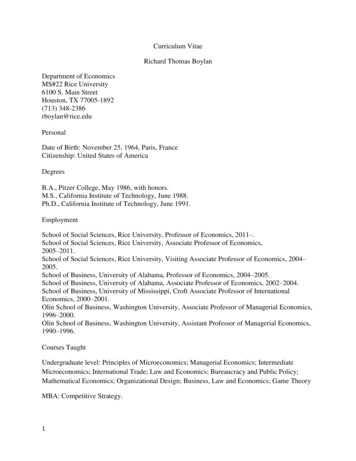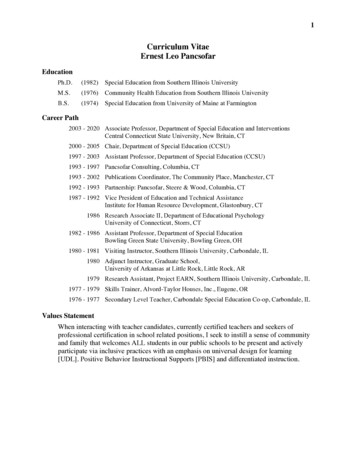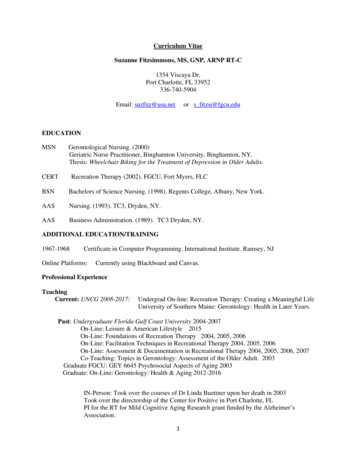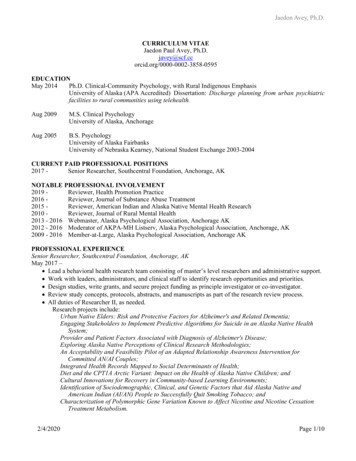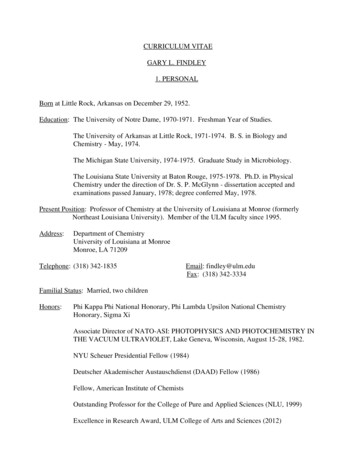
Transcription
CURRICULUM VITAEGARY L. FINDLEY1. PERSONALBorn at Little Rock, Arkansas on December 29, 1952.Education: The University of Notre Dame, 1970-1971. Freshman Year of Studies.The University of Arkansas at Little Rock, 1971-1974. B. S. in Biology andChemistry - May, 1974.The Michigan State University, 1974-1975. Graduate Study in Microbiology.The Louisiana State University at Baton Rouge, 1975-1978. Ph.D. in PhysicalChemistry under the direction of Dr. S. P. McGlynn - dissertation accepted andexaminations passed January, 1978; degree conferred May, 1978.Present Position: Professor of Chemistry at the University of Louisiana at Monroe (formerlyNortheast Louisiana University). Member of the ULM faculty since 1995.Address:Department of ChemistryUniversity of Louisiana at MonroeMonroe, LA 71209Telephone: (318) 342-1835Email: findley@ulm.eduFax: (318) 342-3334Familial Status: Married, two childrenHonors:Phi Kappa Phi National Honorary, Phi Lambda Upsilon National ChemistryHonorary, Sigma XiAssociate Director of NATO-ASI: PHOTOPHYSICS AND PHOTOCHEMISTRY INTHE VACUUM ULTRAVIOLET, Lake Geneva, Wisconsin, August 15-28, 1982.NYU Scheuer Presidential Fellow (1984)Deutscher Akademischer Austauschdienst (DAAD) Fellow (1986)Fellow, American Institute of ChemistsOutstanding Professor for the College of Pure and Applied Sciences (NLU, 1999)Excellence in Research Award, ULM College of Arts and Sciences (2012)
Gary L. FindleyCitations: ACS Directory of Graduate StudiesDirectory of Atomic, Molecular and Optical ScientistsWho’s Who in TechnologyWho’s Who in Frontiers of Science and TechnologyWho’s Who in the EastPersonalities in AmericaInternational Book of Honor2000 Notable Americans5000 Personalities of the WorldInternational Directory of Distinguished LeadershipPersonalities of the AmericasMemberships and Appointments:American Physical Society; American Chemical Society; American Institute ofChemistsEditor of Wiley-Interscience Monographs in Chemical Physics (Wiley-Interscience,New York), 1985 - .Member of CAMD Users Committee, LSU, 2008 - 2017. Chair, 2009 - 11; 2013 2017.Member of SRC Users Advisory Committee, University of Wisconsin, 2009 - 2014.Reviewer for: Journal of Physical Chemistry; The Physical Review; Physical Review Letters;Journal of the American Chemical Society; Chemical Physics Letters; TheoreticaChimica Acta; Biosystems; International Journal of Quantum Chemistry; Journal ofMathematical Chemistry.
Gary L. FindleyOther Appointments: Postdoctoral Research Associate/Visiting Assistant Professor ofChemistry and Director of the Molecular spectroscopy Group, Louisiana StateUniversity (Baton Rouge, Louisiana), 1978-1982.Visiting Professor, Faculty of Science, University of Santa Maria (Valparaiso, Chile),July-August, 1981.Associate Professor of Chemistry, New York University (New York, New York),1982-1986.Visiting Scientist, HASYLAB, Deutsches Elektronen-Synchrotron DESY (Hamburg,Germany), Summers, 1984-1988.Adjunct Associate Professor of Chemistry, Director of Research Development, andCAMD Project Director, Louisiana State University (Baton Rouge, Louisiana), 19861989.Adjunct Professor of Chemistry, University of Arkansas at Little Rock (Little Rock,Arkansas), 1990-1993.Adjunct Professor of Chemistry, Northeast Louisiana University (Monroe,Louisiana), 1993-1995.Interim Dean, College of Pure and Applied Sciences, Northeast Louisiana University(Monroe, Louisiana), January - May, 1997.Adjunct Professor of Chemistry, Louisiana Tech University (Ruston, Louisiana),1999- .Adjunct Professor of Chemistry and Biochemistry, Queens College – CUNY (NewYork, NY), 2009-.Funding:More than 6,000,000 in research funding since 1977, from the Department ofEnergy, National Science Foundation, ACS Petroleum Research Foundation, and theLouisiana Board of Regents Support Fund.CAMD Project Director, US DOE, 25,000,000 (1987-1989).
Gary L. Findley2. RESEARCH INTERESTS1. Molecular electronic spectroscopyExperimental applications of synchrotron radiationVacuum ultraviolet (VUV) spectroscopy of highly-excited states of atoms andmoleculesElectric and magnetic field effects in the VUVVibronic-coupling and intermediate-coupling in Rydberg statesRydberg/valence mixingApplications of quantum defect theory to molecular Rydberg statesDevelopment of ionization potential/term value correlation algorithms for RydbergstatesExternal atom pertuber effects on high-n Rydberg statesPhotoconduction and photoemission in condensed-phase van der Waals systemsDevelopment of band gap/term value correlation algorithms for solid rare gas excitonsPhoto-acoustic spectroscopy of molecular electronic statesAbsorption/emission spectroscopy of highly-polar molecules2. Theoretical ChemistryNonlinear chemical reaction kineticsModel Hamiltonians for molecular problemsDifferentiable-manifold interpretation of Hartree-Fock-Roothaan theory3. Theoretical BiologyGenetic coding theory; generalized genetic codeGeometry and evolutionOrder-isomorphism/order-equivalence relations in group theory and partition theory
Gary L. Findley3. PERSONNEL WHO HAVE STUDIED WITH PROFESSOR GARY L. FINDLEYA. GRADUATE STUDENTS1. Lisa C. Carsweltenure1982-1986degreePh.D.present positionResearch ScientistU.S. Air ForceSandia National LaboratoriesAlbuquerque, NM2. Jonathan A. Wilder1982-1986Ph.D.PresidentH & W Technology, LLCRochester, NY3. Thomas Georgian1982-1986Ph.D.Research ChemistU.S. Army Corps of EngineersCEMRO-HX-COmaha, NE4. Arthur Tringali1983-1985M.S.Analytical ChemistDept. of Water QualityCity of New YorkNew York, NY5. Sam Gilbert1983-1985M.S.Analytical ChemistDept. of Water QualityCity of New YorkNew York, NY6. Massimo Negrin1983-1985M.S.Computer ConsultantNew York, NY7. D. Mark Ortalano1984-1988Ph.D.ManagerR and D/Tech ServiceSun ChemicalAmelia, OH8. John M. Halpin1984-1986M.S.InstructorDept. of ChemistryNew York UniversityNew York, NY9. D. Athanasopoulos1984-1986M.S.Assistant ProfessorDept. of ChemistryPace UniversityNew York, NY1997-19981998-2001M.S.Ph.DAssociate ProfessorDept. of ChemistryQueens College/CUNYFlushing, NY10. C. M. Evans
Gary L. FindleyB. POSTDOCTORAL FELLOWStenure1. Sigrid Bernstorff1984-1986present positionStaff ScientistELETTRASynchrotron RadiationLaboratoryTrieste, Italy
Gary L. Findley4. PUBLICATIONSIn this section are listed research papers, books, book reviews and chapters in books.Abstracts are not listed: The total number published is approximately 50. Reports are also notlisted: The total number prepared is approximately 20.Research Papers:1. G. L. Findley, K. Wittel, W. S. Felps and S. P. McGlynn, “Molecular RydbergTransitions. VIII. The Geometry of Ethylene in the R1s State,” Int. J. Quantum Chem.S11, 229 (1977).2. H. -t. Wang, W. S. Felps, G. L. Findley, A. R. P. Rau and S. P. McGlynn, “MolecularRydberg States. XI. Qauntum Defect Analogies between Molecules and RareGases,” J. Chem. Phys. 67, 3940 (1977).3. J. D. Scott, W. S. Felps, G. L. Findley and S. P. McGlynn, “Molecular RydbergTransitions. XII. Magnetic Circular Dichroism of Methyl Iodide,” J. Chem. Phys. 68,4678 (1978).4.B. Dzhagorov, R. H. Hofeldt, G. L. Findley and S. P. McGlynn, “Host/GuestDeuteration Effects in Mixed Crystals,” Chem. Phys. 37, 195 (1979).5.T. P. Carsey, G. L. Findley and S. P. McGlynn, “Systematics in the Electronic Spectraof Polar Molecules. I. Para Disubstituted Benzenes,” J. Am. Chem. Soc. 101, 4502(1979).6.G. L. Findley, T. P. Carsey and S. P. McGlynn, “Systematics in the Electronic Spectraof Polar Molecules. II. Ortho and Meta Disubstituted Benzenes,” J. Am. Chem. Soc.101, 4511 (1979).7.G. L. Findley and S. P. McGlynn, “A Generalized Genetic Code,” Int. J. QuantumChem., Quantum Biol. Symp. 6, 313 (1979).8.S. P. McGlynn, H. -t. Wang, G. L. Findley, W. S. Felps and A. R. P. Rau,“Applications of Quantum Defect Theory to Molecular Rydberg States,” Spectrosc.Lett. 12, 631 (1979).9.S. P. McGlynn, J. D. Scott, W. S. Felps and G. L. Findley, “Molecular RydbergTransitions. XVI. MCD of CH3Br,” J. Chem. Phys. 72, 421 (1980).
Gary L. Findley10.P. Hochmann, G. L. Findley and S. P. McGlynn, “Molecular Rydberg Transitions. X.Correlation Algorithms for Rydberg Term Values,” Z. Naturforsch. 35a, 595 (1980).Errata, Z. Naturforsch. 35a, 1431 (1980).11.S. P. McGlynn, W. S. Felps, J. D. Scott and G. L. Findley, “Molecular RydbergTransitions. XVIII. Vibronic Doubling in Methyl Iodide,” J. Chem. Phys. 73, 4925(1980).12.G. L. Findley and S. P. McGlynn. “The Generalized Genetic Code. A Modificationof Code Universality,” Int. J. Quantum Chem., Quantum Biol. Symp. 7, 277 (1980).13.W. S. Felps, S. P. McGlynn and G. L. Findley, “Molecular Rydberg Transitions.XVII. Cyanogen Chloride,” J. Mol. Spectrosc. 86, 71 (1981).14.W. S. Felps, J. D. Scott, G. L. Findley and S. P. McGlynn, “Molecular RydbergTransitions. XX. Vibronic Doubling in Alkyl Bromides,” J. Chem. Phys. 74, 4832(1981).15.S. P. McGlynn, W. S. Felps and G. L. Findley, “Molecular Rydberg Transitions. ThePi to 4s Transition of ClCN,” Chem. Phys. Lett. 78, 89 (1981).16.S. Chattopadhyay, J. L. Meeks, G. L. Findley and S. P. McGlynn, “PhotoelectronSpectroscopy of Carbonyls. Saturated Normal Dicarboxylic Acids,” J. Phys. Chem.85, 968 (1981).17.W. S. Felps, G. L. Findley and S. P. McGlynn, “Molecular Rydberg Transitions.Intermediate Coupling in Simple Bromides,” Chem. Phys. Lett. 81, 490 (1981).18.S. Chattopadhyay, G. L. Findley and S. P. McGlynn, “Photoelectron Spectroscopy ofPhosphites and Phosphates,” J. Electron Spectrosc. 24, 27 (1981).19.G. L. Findley and S. P. McGlynn, “Geometry and Evolution,” Int. J. Quantum Chem.,Quantum Biol. Symp. 8, 455 (1981).20.S. P. McGlynn and G. L. Findley, “Giant-Molecule Interactions,” J. Photochem. 17,461 (1981).21.J. A. Dagata, G. L. Findley, S. P. McGlynn, J. -P. Connerade and M. A. Baig,“Molecular Rydberg Transitions. Multichannel Approaches to Electronic States:CH3I,” Phys. Rev. A 24, 2485 (1981).22.A. M. Findley, G. L. Findley and S. P. McGlynn, “Genetic Coding: Approaches toTheory Construction,” J. Theor. Biol. 97, 299 (1982).
Gary L. Findley23.G. L. Findley, A. M. Findley and S. P. McGlynn, “Symmetry Characteristics of theGenetic Code,” Proc. Natl. Acad. Sci. USA 79, 7061 (1982).24.A. M. Findley and G. L. Findley, “The Generalized Genetic Code. A Note on OrderIsomorphism/Order-Equivalence Relations,” Int. J. Quantum Chem., Quantum Biol.Symp. 9, 59 (1982)25.P. Hochmann, S. P. McGlynn and G. L. Findley, “Ionization Potential Correlationsfor Alkyl-Substituted Chromophores,” Int. J. Quantum Chem., Quantum Biol. Symp.9, 173 (1982).26.D. Kumar, R. V. Nauman, R. Mohanty, S. P. McGlynn and G. L. Findley, “LaserPower Fluctuations: An Analog Signal-Correction Technique,” Rev. Sci. Instrum. 54,463 (1983).27.T. Georgian and G. L. Findley, “Hamiltonian Formulations of Chemical Kinetics,”Int. J. Quantum Chem., Quantum Biol. Symp. 10, 331 (1983).28.G. L. Findley, P. Hochmann and S. P. McGlynn, “Correlation Algorithms forIonization Energies and Rydberg Term Values. I,” Ann. Israel Phys. Soc. 6, 161(1983).29.G. L. Findley, P. Hochmann and S. P. McGlynn, “Correlation Algorithms forIonization Energies and Rydberg Term Values. II,” Ann. Israel Phys. Soc. 6, 164(1983).30.A. M. Findley and G. L. Findley, “Genetic Coding Theory. Multiple MitochondrialGenetic Codes,” Int. J. Quantum Chem., Quantum Biol. Symp. 11, 109 (1984).31.T. Georgian, J. M. Halpin and G. L. Findley, “Hamiltonian Dynamics of SimpleChemical Reactions,” Int. J. Quantum Chem., Quantum Biol. Symp. 11, 347 (1984).32.A. M. Findley and G. L. Findley, “Genetic Coding Theory: Alternative GeneticCodes,” Ann. N. Y. Acad. Sci. 435, 537 (1984).33.P. E. Moroz and G. L. Findley, “Development of a Giga-g MagneticMicrocentrifuge,” Anal. Instrum. 13, 217 (1984-1985).34.S. P. McGlynn, A. M. Langsjoen, P. Hochmann, P. Brint and G. L. Findley,“Correlation Algorithms for Ionization Energies. Alkyl Derivatives,” J. Phys. Chem.89, 1157 (1985).
Gary L. Findley35.V. Saile, R. Reininger, A. M. Koehler and G. L. Findley, “Electric Field Dependenceof the Total Excimer Luminescence of Xenon Excited Below the Atomic IonizationLimit,” Nucl. Instr. Meth. A 238, 558 (1985).36.A. M. Findley, S. P. McGlynn and G. L. Findley, “Applications of DifferentialGeometry to Molecular Genetics,” J. Biol. Phys. 13, 87 (1985).37.A. M. Koehler, R. Reininger, V. Saile and G. L. Findley, “Denisty Effects on High-nMolecular Rydberg States. CH3I in Argon,” Phys. Rev. A 33, 771 (1986).38.S. Bernstorff, V. Saile and G. L. Findley, “Term Value/Band-Gap EnergyCorrelations for Solid Rare Gas Excitons,” Chem. Phys. Lett. 125, 161 (1986).39.A. M. Findley, S. Bernstorff and G. L. Findley, “Systematics in the IonizationEnergies of Rare Gas Clusters,” Chem. Phys. Lett. 131, 349 (1986).40.A. M. Koehler, R. Reininger, V. Saile and G. L. Findley, “Density Effects on High-nMolecular Rydberg States. CH3I in He, Ne, Ar and Kr,” Phys. Rev. A 35, 79 (1987).41.A. M. Findley, S. Bernstorff, A. M. Koehler, V. Saile and G. L. Findley,“Photoionization Spectroscopy of Highly-Polar Aromatics. Halobenzonitriles,” Phys.Scrip. 35, 633 (1987).42.J. A. Wilder and G. L. Findley, “Construction of a Two-Photon PhotoacousticSpectrometer,” Rev. Sci. Instrum. 58, 468 (1987).43.T. Georgian and G. L. Findley, “Hamiltonian Dynamics of Chemical Reactions,” J.Comp. Chem. 8, 744 (1987).44.J. A. Wilder, T. Georgian and G. L. Findley, “Systematic Corrections to the BornOppenheimer Approximation,” Chem. Phys. Lett. 137, 345 (1987).45.A. M. Koehler, V. Saile, R. Reininger and G. L. Findley, “Sudden and AdiabaticPolarization Effects in Doped Rare Gases,” Phys. Rev. Lett. 60, 2727 (1988).46.V. Saile, R. Reininger, P. Laporte, I. T. Steinberger and G. L. Findley, “QuantumDefect Method and Valence Excitons in Rare Gas Solids,” Phys. Rev. B 37, 10901(1988).47.B. C. Craft, A. M. Findley, G. L. Findley, S. P. McGlynn, J. D. Scott and F. H.Watson, “LSU Center for Advanced Microstructures and Devices,” Rev. Sci. Instrum.60, 2144 (1989).
Gary L. Findley48.B. C. Craft, A. M. Findley, G. L. Findley, J. D. Scott and F. H. Watson, “StatusReport on the CAMD Project,” Nucl. Inst. Meth. B 40/41, 379 (1989).49.C. M. Evans, R. Reininger and G. L. Findley, “Photoionization Spectra of CH3IPerturbed by SF6: Electron Scattering in SF6 Gas,” Chem. Phys. Lett. 297, 127(1998).50.C. M. Evans, R. Reininger and G. L. Findley, “Subthreshold Photoionization Spectraof CH3I Perturbed by SF6,” Chem. Phys. 241, 239 (1999).51.C. M. Evans and G. L. Findley, “A New Transformation for the Lotka-VolterraProblem,” J. Math. Chem. 25, 105 (1999).52.C. M. Evans and G. L. Findley, “Analytic Solutions to a Family of Lotka-VolterraRelated Differential Equations,” J. Math. Chem. 25, 181 (1999).53.C. M. Evans, R. Reininger and G. L. Findley, “Subthreshold Photoionization of CH3Iin Ar, N2 and CO2,” Chem. Phys. Lett. 322, 465 (2000).54.C. M. Evans, J. D. Scott, F. H. Watson and G. L. Findley, “Photoionization Studies ofC2H5I and C6H6 Perturbed by Ar and SF6,” Chem. Phys. 260, 225 (2000).55.C. M. Evans and G. L. Findley, “Analytic Solutions to a Class of Two-DimensionalLotka-Volterra Dynamical Systems,” Disc. Cont. Dynam. Sys. 6, 137 (2000).56.C. M. Evans, E. Morikawa and G. L. Findley, “Pressure Studies of SubthresholdPhotoionization: CH3I, C2H5I and C6H6 Perturbed by Ar and SF6,” Chem. Phys. 264,419 (2001).57.C. M. Evans and G. L. Findley, “Pressure Studies of Subthreshold Photoionization:CH3I Perturbed by CF4 and c-C4F8,” Chem. Phys. Lett. 337, 375 (2001).58.C. M. Evans, E. Morikawa and G. L. Findley, “Photoionization Spectra of CH3I andC2H5I Perturbed by CF4 and c-C4F8: Electron Scattering in Halocarbon Gases,” J.Phys. B: At. Mol. Opt. Phys. 34, 3607 (2001).59.C. M. Evans and G. L. Findley, “Energy of the Quasi-Free Electron in Argon andKrypton,” Phys. Rev. A 72, 022717 (2005).60.C. M. Evans and G. L. Findley, “Energy of the Quasi-Free Electron in SupercriticalArgon near the Critical Point,” Chem. Phys. Lett. 410, 242 (2005).61.C. M. Evans and G. L. Findley, “Field Ionization of C2H5I in Supercritical Argon nearthe Critical Point,” J. Phys. B: At. Mol. Opt. Phys. 38, L267 (2005).
Gary L. Findley62.Luxi Li, C. M. Evans and G. L. Findley, “Energy of the Quasi-Free Electron inSupercritical Krypton near the Critical Point,” J. Phys. Chem. A 109, 10683 (2005).63.Xianbo Shi, Luxi Li, C. M. Evans and G. L. Findley, “Energy of the Quasi-FreeElectron in Xenon,” Chem. Phys. Lett. 432, 62 (2006).64.Xianbo Shi, Luxi Li, C. M. Evans and G. L. Findley, “Energy of the Quasi-FreeElectron in Argon, Krypton and Xenon,” Nuc. Instrum. Meth. A 582, 270 (2007).65.Xianbo Shi, Luxi Li, Gina M. Moriarty, C. M. Evans and G. L. Findley, “Energy ofthe Quasi-Free Electron in Low Density Ar and Kr: Extension of the Local WignerSeitz Model,” Chem. Phys. Lett. 454, 12 (2008).66.Luxi Li, Xianbo Shi, C. M. Evans and G. L. Findley, “Xenon Low-n Rydberg Statesin Supercritical Argon near the Critical Point,” Chem. Phys. Lett. 461, 207 (2008).67.Luxi Li, Xianbo Shi, C. M. Evans and G. L. Findley, “CH3I Low-n Rydberg States inSupercritical Atomic Fluids near the Critical Point,” Chem. Phys. 360, 7 (2009).68.Xianbo Shi, Luxi Li, G. L. Findley and C. M. Evans, “Energy of the Excess Electronin Methane and Ethane near the Critical Point,” Chem. Phys. Lett. 481, 183 (2009).69.Luxi Li, Xianbo Shi, G. L. Findley and C. M. Evans, “ Dopant Low-n Rydberg Statesin CF4 and CH4 near the Critical Point,” Chem Phys. Lett. 482, 50 (2009).70.C. M. Evans and G. L. Findley, “Energy of the Conduction Band in near CriticalPoint Fluids,” Phys. Res. Internat. 2010, 749293 (2010).71.C. M. Evans, Yevgeniy Lushtak and G. L. Findley, “Energy of the Quasi-FreeElectron in Dense Neon,” Chem. Phys. Lett. 501, 202 (2011).72.C. M. Evans, Yevgeniy Lushtak, Xianbo Shi, Luxi Li and G. L. Findley,“Temperature Effects on the Perturber Induced Shift of Dopant Ionization Energies inHe and Ne,” Chem. Phys. Lett. 505, 16 (2011).73.Yevgeniy Lushtak, C. M. Evans and G. L. Findley, “Field Enhanced Photoemission:A New Technique for the Direct Determination of the Quasi-Free Electron Energy inDense Fluids,” Chem. Phys. Lett. 515, 190 (2011).74.Yevgeniy Lustak, Samantha B. Dannenberg, C. M. Evans and G. L. Findley, “QuasiFree Electron Energy in Near Critical Point Helium,” Chem. Phys. Lett. 538, 46(2012).
Gary L. Findley75.Yevgeniy Lushtak, C. M. Evans and G. L. Findley, “The Energy of the Quasi-FreeElectron in Near Critical Point Nitrogen, Chem. Phys. Lett. 546, 18 (2012).76.C. M. Evans, Holden T. Smith, Ollieanna Burke, Yevgeniy Lushtak and G. L.Findley, “Field Ionization and Photoionization of CH3I Perturbed by Diatomic Fluids:Electron Scattering in H2, HD, D2 and O2,” J. Phys. B: At. Mol. Opt. Phys. 47,035204 (2014).77.C. M. Evans, Kamil Krynski, Zachary Streeter and G. L. Findley, “Energy of theQuasi-Free Electron in H2, D2 and O2: Probing Intermolecular Potentials within theLocal Wigner-Seitz Model,” J. Chem. Phys. 143, 224303 (2015).78.C. M. Evans, Baxter Flor, Kamil Krynski, Zachary Streeter and G. L. Findley,“Energy of the Quasi-Free Electron in CO and HD: Probing Intermolecular Potentialswithin the Local Wigner-Seitz Model,” J. Chem. Phys. 149, 064307 (2018).79.C. M. Evans, Jennifer Hare, Baxter Flor and G. L. Findley, “The Quasi-Free ElectronEnergy in Supercritical and Near Critical Tetrafluoromethane in Comparison toMethane,” J. Phys. Chem. A, to be submitted (2019).80.L. C. Carswell, A. M. Findley and G. L. Findley, “Luminescence Properties of HighlyPolar Aromatics,” J. Am. Chem. Soc., in preparation.81.D. M. Ortalano and G. L. Findley, “An Electronic Adiabatic Approximation forRydberg States,” Chem. Phys. Lett., in preparation.
Gary L. FindleyBooks:1. S. P. McGlynn, G. L. Findley and R. H. Huebner, eds., Photophysics and Photochemistryin the Vacuum Ultraviolet, D. Reidel Publishing Co., Dordrecht, Holland, 1985.2. A. M. Findley, S. P. McGlynn and G. L. Findley, The Geometry of Genetics, WileyMonographs in Chemical Physics, Jo
8. John M. Halpin 1984-1986 M.S. Instructor Dept. of Chemistry New York University New York, NY 9. D. Athanasopoulos 1984-1986 M.S. Assistant Professor Dept. of Chemistry Pace University New York, NY 10. C. M. Evans 1997-1998 M.S. Associate Professor 1998-2001
